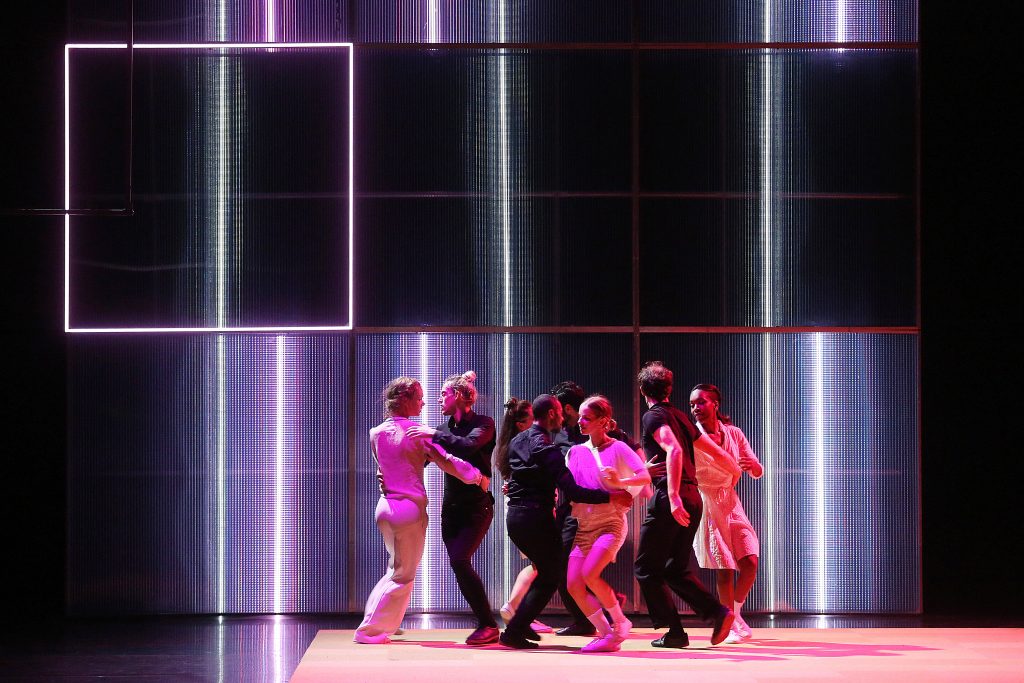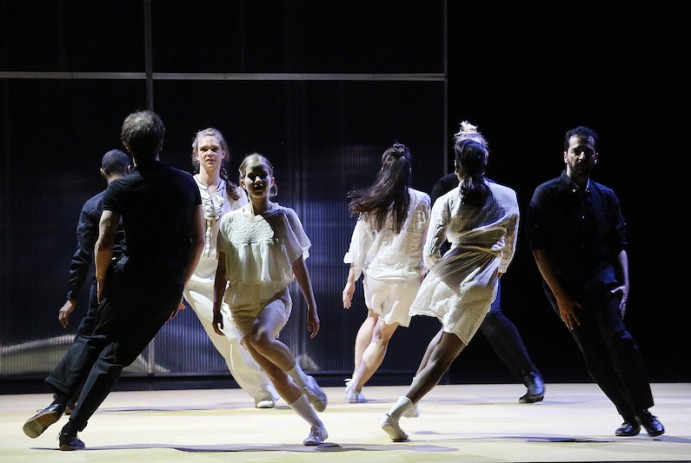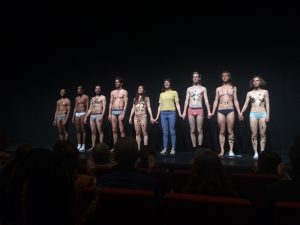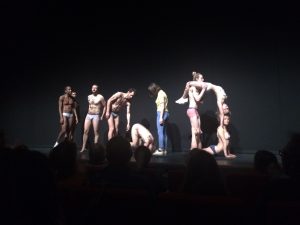The honour of opening Utrecht's dance and performance festival SPRING fell this year to choreographer Nicole Beutler[hints]Nicole Beutler (Munich, 1969) is a choreographer and theatre maker. After studying Fine Arts at the Art Academy (Münster and Munich), she came to Amsterdam for the AHK's School for New Dance Development, where she graduated in 1997. Her work is at the interface of visual art, theatre and dance(Source)[/hints]. The performance 6: The Square exhibits an inimitable fascination with dancing and thinking in squares. Squaredance, a very old folk dance tradition in couples, especially popular in America, and the futuristic functionality of Bauhaus are linked in this choreography to thoughts about creating order and pigeonholing. How exactly and why is not made clear.
At the top of Tim Vermeulen & Nico van Rooij's impressive, detached and transparent set, a digital clock counts back time. Transparency, an idea of clarity obtained through measurement and 'objective' data production, is an almost maddening aspect of our time. It seems as if Beutler wants to undo this phenomenon in a symbolic way, counting back from 65 minutes to 0 and then celebrating an organic order with a Nirvana-like final scene outside measured time. It's all very straightforward and naive thinking, but that's apparently what thinking in squares entails for Beutler.

For the eight dancers who spend the first 10 minutes of the performance in black rain suits in semi-darkness, the sweat is raining inside. The physical and social aspects of the highly ingenious Squaredance-routines are thus hidden from view by Beutler, tucked away in a formless uniformity. Only from a great distance can the development of a play of lines be seen. In a subsequent scene, the couples dance phrases of gathered together gestes from different dance styles, while playing with the spatial dynamics of the square floor. Both dance scenes produce all kinds of aesthetic pictures, but also deliberately steer towards the nonsensical. In between, for instance, the actress Deborah Abrahams does a long monologue with the words "Oh my, oh my". It is only when Abrahams again comes on stage alone and dances a dance that something makes its appearance beyond the available dancer, machinelle performer and regulatory systematics.
Cynical message?
In a stack of seemingly unconnected scenes, set to the relentless flow of beats in four by Gary Shepherd, couples dancing evolves from anti-social and closed - through a joyful, traditionally organised and truly impressive squaredance-variation -to an orgasmic apotheosis. Whereas Bauhaus sought to develop a universal, universally accessible and emancipatory aesthetic for the future, focusing on primary forms, colours and functions, proclaims 6: The Square with droning repetition a cynical message: we can't go back in time, but then or thereabouts is better.

Dance actually matters little in 6: The Square. He is used symbolically, as grateful material to mould into any imaginable regime. The actress, who miraculously manages to hold her own among all the physical-visual violence, sets the tone in texts and actions. From complete confusion, via a human dance, a touch of audience participation and a seductive a-political propaganda speech to a tale of the fall.
The square is claimed to have been invented by humans. Beutler, in a Catholic way, projects all the bad into it. While at the end of the performance, the squaredance-organisation lapses into an orgy bathed in pink light (it's still pictures), comes Abrahams as the dance leader, or 'caller' as used in squaredance hot, with a final gasp over a dramatic fall on the dance floor. The fall could have been her salvation: to be included in the orgasmic play on the floor. But she doesn't want to. "It's not her thing," she claims. 'To fit in or not to fit in' - it seems to be the only question that comes to Beutler's mind when she deals with squares, or arrangement in general. This is disappointing.
Organic shapes and fractals make happier?
A certain absurdism goes down well with Beutler. Deploying symmetry as a nonsensical but nevertheless effective, because soothing, form has so far produced fascinating group pieces, such as The Garden, where although the form is closed, a kaleidoscopic multiplication of elements invites play. Beutler is also good at recycling and deconstructing existing material, be it Lucinda Childs, Les Sylphides or Bianca van Dillen. Here, the mutual functioning of the group often plays a major role, and a fairly direct relationship with the audience is also sought. A duet like 4: STILL LIFE is then again moving in its consistent simplicity and concentration. Similarly, for example, the simplicity of the proposal in the dance film Diamond Dancers, which Beutler made with Racké and Musken, is effective and convincing.

Refusing to be difficult, asking simple questions and making simple suggestions can be very effective in approaching complex issues. But in 6: Square Beutler seems to have lost her way, repeating herself instead of breaking into another person or, in this case, herself. A game of rules is missing.
The theme of the do-gooder - "Do we care? Anyone who cares for anything, please raise your hand!" shouts Abrahams midway through the performance - is super hip in the art world right now. Unfortunately, in 6: The Square, beyond a kind of biting irony, made no connection between the tradition of couples dancing and any kind of political or even socially engaged business. The speeches of the caller seem like the last belches of a disappointed individual. Indulging in organic forms, for example in the form of collective happy love making - is an all too easy proposition for me. And the only organic, unregulated moment in this performance occurs when the dancers leave the formality of the choreography and take the applause.
But what does that have to do with Bauhaus?


